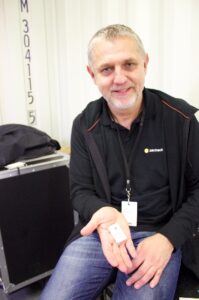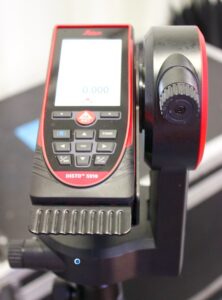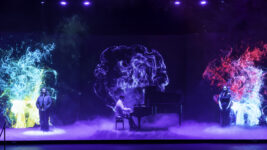News
23 Apr 2018
Zactrack: How It Works

Subscribe to CX E-News
FEATURES
Zactrack: How It Works

Paul Roch with the CORE tablet interface

Werner Petricek with a Zactrack tag
With a gig as globally prestigious as Handa Opera on Sydney Harbour, and Opera Australia sizing up the tech for future use, Zactrack CEO Werner Petricek and Project Manager Paul Roch were on-hand in Sydney to make sure the OA’s techs had all the guidance they needed. We talked to them in detail about the system
By Jason Allen.
Zactrack’s transmitters, known as tags, are small rectangular boxes that transmit ultra wide-band radio in the 3-4gHz range.
They’re low powered, and are in a license-free band with little or nothing else in it in all major markets, including the EU, USA, Australia, and Japan. They’re ideally placed high on the performer, under the costume. As it’s not line-of-sight like an infra-red system, it can be hidden anywhere except behind significant amounts of metal, which interferes with radio. The tags run on a rechargeable lithium battery, with a recharging station capable of charging 30 tags at once. The largest amount of tags Zactrack have used on one show is 53, but the system could use more if necessary.
Get On Track
“Zactrack is one of the oldest companies doing tracking,” explained Werner. “We’ve been active since 2005, and have been doing large touring shows since 2009. Tracking itself is tricky, and took us some time to get it to this level where it’s now applicable to 90% of situations, and easy for designers to implement.When we started out, we underestimated the amount of math we needed to cope with. We learnt our lessons, and now we have a different idea of how tracking on stages works.
“We divide the task of tracking into three distinct processes,” continued Werner.
“Creating and receiving the positioning data, doing the math that calculates all of the parameters, and lastly, communications and control. Only when all three parts are right does it work. Every section takes time; calculation time and computing time. It’s a lot of prediction mathematics to know where the performer will move next so you can get the light ahead of them, sometimes up to half a second ahead.”
Anchors Away
The Zactrack system’s antennas are called anchors. “On a stage production, we typically use a minimum of ten anchors,” Werner elaborated. “Having more anchors doesn’t make the data more accurate, it’s about getting total coverage of complex spaces. For BMW, we once tracked cars through tunnels, and we used 28 anchors. In an open field, six would likely be enough.”
Setting up the Zactrack system for lighting tracking is a three-step process – mount, measure, and align. After the anchors have been mounted in the space, their positions are measured using a Leica Disto S910 laser device connected to the same WiFi network as the processor, from a defined zero point on stage. Each anchor has a yellow dot, and the laser is shone onto to each dot to confirm to the system the anchor’s position in 3D space.
On The Network
The next step is using the ingenious sensor puck – a small puck with a light sensor built in. Pucks are positioned at four points on the stage where the 3D coordinates are known. They are activated and connected to the Zactracks WiFi network, and each light shone onto the puck four times, taking five to 10 seconds per light. The Zactrack CORE software can then calculate everything it needs to know from that data.
The heavy lifting is done in the Zactrack CORE computer. “It receives the x-y-z coordinates, which are accurate down to plus or minus 5 centimetres,” Werner stated. “CORE then does the calculations to get the correct pan and tile angle of the lighting fixture. To calculate that, it needs to know where the light is and the orientation of the light. From that, it can calculate every position in 3D. On the output side, we support any kind of lighting protocol; ArtNet, DMX, sACN, OSC or whatever else you want.
“We take the info from the console and can control any moving light on the market. We have found that the accuracy of fixtures varies from manufacturer to manufacturer, and the speed of the fixture is an issue if the performer is moving quickly and stopping fast.”
Tour-Proof
Werner believes Zactrack is now mature enough for use in almost all production situations. “With new technology, there’s always fear and uncertainty,” he mused. “We learned there’s a difference between having a working piece of technology and it be suitable for use on tour. Tours need to run for six months, load in and out in 10 hours, and not take too long to align the lights.
“We can get these systems aligned in around an hour. Zactrack is tour-proof, accurate and fast enough to do lighting, robust enough for bad conditions, works in the dark, and works in the sun.”
This article first appeared in the print edition of CX Magazine April 2018, pp.20-21. CX Magazine is Australia and New Zealand’s only publication dedicated to entertainment technology news and issues. Read all editions for free or search our archive www.cxnetwork.com.au
See also: Track the Light Fantastic, Opera Australia’s use of the system on La Boheme in 2018.
Subscribe
Published monthly since 1991, our famous AV industry magazine is free for download or pay for print. Subscribers also receive CX News, our free weekly email with the latest industry news and jobs.









